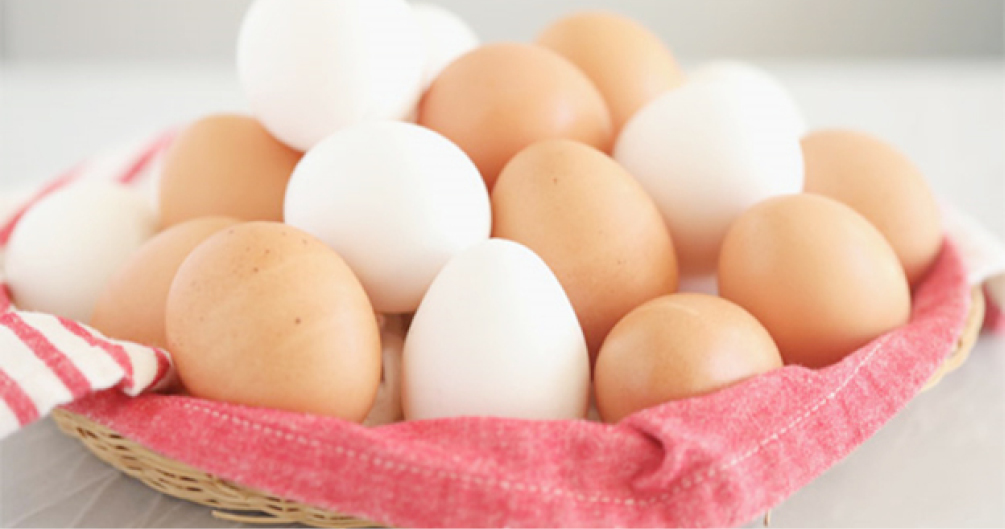I’ve been taking an online course from the American Egg Board directed at food service chefs. I am not in the food service industry, but I have learned so much about egg farms, food safety, and nutrition. I’m only halfway through the course, but thought I’d share six things I’ve learned so far about eggs.
- There are many breeds of chicken and the breed determines the colour of the eggshell. You can also look at the chicken’s earlobes to see what colour the shell will be. Yes, chickens have ears. Brown eggs, which are more common in the northeastern United States, are laid by chickens with red feathers and earlobes. Chickens with white feathers and ear lobes lay white eggs.
- It doesn’t matter what colour the eggshell is, what quality grade it is, or how the hens who laid the chickens were raised – the nutritional content is similar. The size of the egg does affect its nutritional value. If hens were fed enriched feed, then the eggs may have enhanced nutrition. You can expect those eggs to be more expensive due to increased feed costs for the hens.
- An egg’s shell has around 17,000 pores. These tiny holes let air and moisture pass through the shell. They also allow odour to pass into the egg, so keep strong smelling food like fish or onions away. The egg carton helps protect the egg from absorbing odours, so I won’t be using the egg tray that came with our refrigerator.
- Eggs may be small, but they pack a huge punch when it comes to nutrition. One large egg has 70 calories, 6 grams of protein, and 8 essential nutrients. Almost half the protein is found in the egg’s yolk, so eating only egg whites means you’re missing out on all the egg’s nutritional benefits.
- Try bobbing for eggs to see how fresh one is. Inside the egg is an air pocket, which gets larger as the egg ages. If the air pocket gets large enough, the egg will float. Throw away any eggs that float.
- On the side of the carton there is a “Use By” date and another number. I’ve always wondered what that number was. It’s the Julian date, which is the day of the year the eggs were washed, graded, and packed in the carton. If you see “001” on the carton, those eggs were packed on January 1. If packed on July 1, you will see “182” on the carton, as that is the 182nd day of the year.
I’m just starting the sections on cooking eggs, and since my experience starts and stops at scrambled eggs, I can’t wait to learn more ways to cook them.
Dry season farming in Kogi low this year
Feeding Chickens For Orange Yolks
When you crack open an egg and see a vibrant yellow or orange egg yolk, most people assume that’s a sign of a fresh, especially nutritious egg. And it might even taste better.
Jacquie Jacob is an Extension poultry associate at the University of Kentucky. She says a dark yellow or orange yolk doesn’t typically mean it’s healthier or fresher. These yolks are higher in beta carotene, which is a vitamin A precursor. But whether this has biological significance or not is debatable. Jacob says the colour of the yolk is a sign of what the chicken ate.
“We usually find oranger yolks with chickens raised on pasture with nice lush grass, or legumes that they eat,” says Jacob. “The pigment, the xanthophyll from that foliage, gets deposited into the yolk, giving it an oranger colour.”
If your chickens aren’t pastured, Jacob says you can supplement their diet to get an orange yolk.
“The commercial guys when they want a darker yolk, they use marigold petals, the powder from it. You can also use dehydrated alfalfa if you don’t want to go that route because you’re getting the dry foliage that still has the pigments in it,” says Jacob. “So, typically a diet high in dehydrated alfalfa will give you darker yolks.”
You can also give your chickens treats that are high in xanthophyll, such as carrots, apricots, pumpkins, red cabbage, and the leaves of most green plants.
Some chicken breeds that have yellow skin and are fed diets high in xanthophyll will also have darker, more richly-coloured feet and beaks, because any excess pigment not used to produce eggs is stored. This is why roosters with xanthophyll in their diet tend to have very yellow feet and beaks.
SOURCE: Successful Farming



